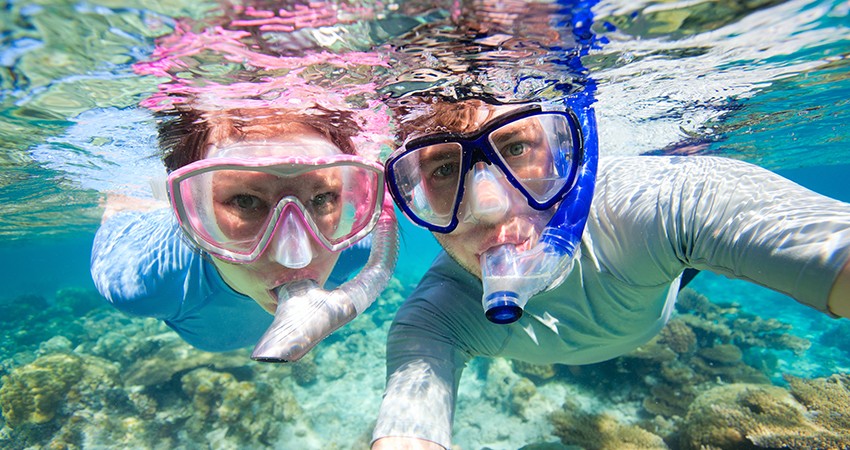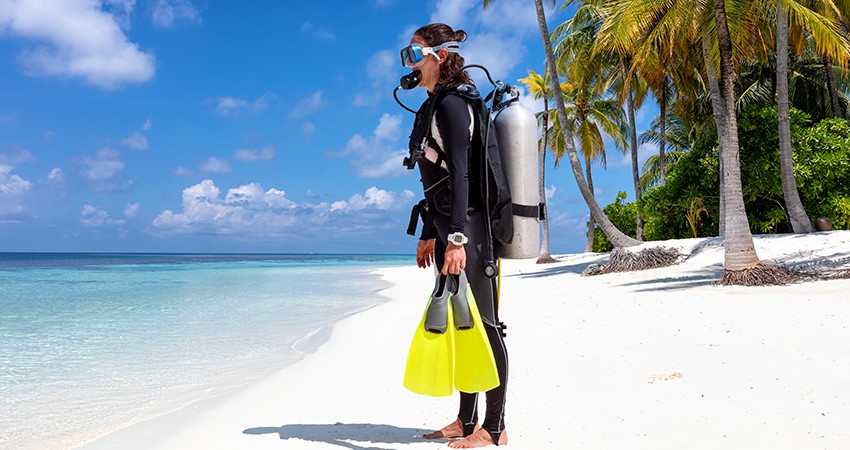Diving Sites in Port Blair







Want to take underwater photographs that you will be proud to share with others? If yes, then take the PADI Digital Underwater Photographer course. Photography is an art, especially when it is done under water. With this course, you will get tips from the experts and thus, the learning curve will be shortened. You will also avoid beginner mistakes. You will learn a lot of things such as using underwater photography lights (strobes), avoiding backscatter, enhancing colour, and a lot more.
Download Medical FormTake the Digital Underwater Photographer course if you want to:
- Reduce backscatter
- Share your scuba adventures
- Use your action camera underwater
You will learn how to:
- Photograph marine life
- Use underwater strobes
- Choose photo equipment
Learn underwater photography – Start Today
Take Great Underwater Photos
Through trial and error, you can spend hours learning underwater photography, or you can simply take a shortcut! In this course, you will be taught professional tricks and tips for taking great photos underwater. You will also learn the best ways to capture videos with a GoPro or other action camera.
Independent Study- PADI eLearning
With this online course, you can easily learn underwater photography fundamentals along with composition, shooting angles, lighting, and photographer etiquette. One can easily fit photography lessons into a hectic routine with the help of PADI eLearning. The independent study part of the course can be completed whenever and wherever it’s convenient to you. Online or offline, you can work at your own pace using a mobile device or a computer. Also, you can talk to your instructor for in-water training and in case of any doubts.
eLearning time commitment: 2-4 hours
At the Dive Shop - With your Instructor
You will be doing two dives in order to get hands-on experience of taking photos with a compact camera or action camera. You can use your own or rent one. For getting excellent shots, you will be using the SEA (Shoot, Examine, Adjust) method.
- Prerequisites: Certified diver / Junior OW Diver (or qualifying certification)
- Total time commitment: 2 days
- Minimum age: 10 years or older
Medical Requirements
Keep the following things in mind regarding medical requirements for scuba diving:
- One should have a minimum level of health and fitness for scuba diving. In case of any chronic health conditions, certain medications and/or recent surgery, one may have to get written approval from a physician before the dive.
- In order to avoid any hassle, you can download and review the Diver Medical form. With this, you can know before enrolling in a scuba course that you will not need a physician’s approval for diving.
- You should not ask for any medical advice from instructors, divemasters, and dive shop staff as they are not physicians. Only medical professionals can give medical clearance to scuba dive.
- In case of any confusion regarding medical fitness, you can contact the experts at Divers Alert Network (DAN).
Prerequisites & Minimum Age
- Minimum Age: 10 years
- Course prerequisites: (Junior) Open Water Diver or equivalent entry-level certification
Other Costs & Equipment
PADI Digital Underwater Photographer course comprises knowledgeable development as well as in-water training for certification. If you buy a PADI eLearning course, then only the knowledge development part is covered. In order to complete your certification with a PADI instructor, there will be an additional cost. The charges will depend on class size, environment, and whether or not you need to rent scuba diving equipment.
For more details about pricing, contact Dive Andaman, which is a 5-star PADI centre in Havelock Island (Swaraj Dweep). Along with basic scuba equipment, you will also be requiring a digital underwater camera and a computer or other device in order to download and view images. Depending on your camera system, your instructor may suggest additional equipment and accessories. It is highly recommended that you use your own camera, strobes, etc. during the course. By doing so, you will become familiar with their functioning.
Time Commitment
- PADI eLearning: 2-4 hours
- Entire course: 2 days
Available Languages
- English
- Contact Dive Andaman for information on other available languages.
System Requirements
The online courses of PADI work on the browsers listed below: Ensure that your browser is updated to have the best experience.
- Chrome
- Safari
- Edge
- Firefox
You can also study at a location that has no internet access. Just use the PADI Training app to download course content and study offline. You can download the content in small sections with a total file size of around 13.9 MB. You can upload your progress when you get back online. This will help you in resuming your training right where you left off. The app is available for Android as well as Apple iOS devices. Devices should not be more than three models old and updated with the latest Operating System (OS).
What After the PADI Digital Underwater Photographer Course?
The first dive of the Digital Underwater Photographer Specialty course may be counted toward your Advanced Open Water Diver certification. Ask your instructor at Dive Andaman about earning credit. Each completed PADI speciality is a step closer to earning the elite Master Scuba Diver rating.
Best Sites for Underwater Photography & Videography in Havelock Island (Swaraj Dweep)
Havelock Island is known for having a total of nine outstanding locations that are great spots for diving as well as underwater photography. Going under the depths of these waters is exactly the type of experience that you are looking for.
Barracuda City
For beginners, this is simply the best spot for diving. It is completely different from other locations as you can see long strips of coral belts with the perfect blend of hard as well as soft coral populations. Its rich ecosystem offers tons of fish of diverse species and colours. And if you are lucky enough, then you can spot wandering sea turtles near the corals.
Turtle Bay
As evident from the name, Turtle Bay has plenty of sea turtles. Moreover, you can also spot corals and Rays in abundance here. This spot is perfect for you if you are a true lover of natural marine life. The depth of water doesn’t exceed fourteen meters, thus making it a decent destination for inexperienced divers.
Seduction Point
Divers looking for something exclusive should know that this is a perfect diving spot in Havelock Island owing to the shallow water, a large number of inhabitants including Napoleons, and a dense population of hard staghorn corals.
Mac Point
Popular for hard corals and small groups of fish, you can reach this place by boat. The capital animal of Andaman- Dugong, which is also known as sea-cow, can be easily spotted here.
Aquarium
Promising a lot to beginners, this spot is a bit offshore at a distance of three kilometres from Elephant Beach. It houses fringing reefs that are crowded with large groups of colourful fishes.
The Wall
Allowing for a very unique view of the underwater world, this is a huge underwater rock that drops down to 56 meters.
Minerva Ledge
It is simply described as an enormous block of hard corals in clear waters, with sea dwellers including sharks. The site is only recommended for experienced divers.
Pilot Reef
Only recommended for experienced divers, this is a long strip of the underwater canyon, which is nearly 24 meters deep.
Lighthouse
If you want to witness the perfect balance of vibrant fish and soft & hard corals, then this is your one-stop destination. The water is shallow but gets deeper as you move farther from the shore.
Other scuba diving sites in Havelock Island are as mentioned below. These are also great for underwater photography.
- M4
- Jackson’s Bar
- Jonny George
- Broken Ledge
- Dicksons Pinnacle
- Whitehouse Rock
- MV Mars
- Red Pillar
- The Slope
- Purple Haze
- S.S. Inchkett
Please note: Consumption of alcohol or any other intoxicating products is strictly prohibited before scuba diving.
Things to Carry for Scuba Diving
- Towel
- Water bottle
- Extra set of clothes
- Personal medicine kit, if needed
Reaching Havelock Island
There are ferries plying from Port Blair that take nearly two and a half hours to reach Havelock Island. Booking in advance is not mandatory. You can ask your hotel/resort receptionist to book it for you.
In Havelock Island, you can indulge yourself in the fascinating activity of scuba diving and make your trip unforgettable. Second, to none, its rich marine life and coral population offers a great experience. When you are under the water, vibrant and colourful fish will surround you. If you want to become a licensed or professional diver, then you will be happy to know that Dive Andaman located in Havelock Island offers different certifications as well as fun dives. You can dive at different dive sites around the world once you get the diving card.
We know that ticking off scuba diving from your bucket list is long due, and Havelock Island is the best place in Andaman to do it. Book your dive with us to have the best experience ever! This 5-star PADI facility will take care of all your requirements to ensure that you have a wonderful dive.
Frequently Asked Questions
-
Q. 1 : What certification will I receive upon completing the course?
Upon completing the PADI Digital Underwater Photographer course, you will receive a PADI Digital Underwater Photographer specialty certification card.
-
Q. 2 : How much does the course cost?
The cost of the course varies depending on the dive center and the location, but it typically ranges from INR 15,000 to INR 25,000.
-
Q. 3 : What are the benefits of taking the course?
The PADI Digital Underwater Photographer course can help you improve your underwater photography skills, allowing you to capture and share your diving experiences in a more meaningful way. It can also help you develop a deeper understanding and appreciation of the underwater environment and the creatures that inhabit it.
-
Q. 4 : Can I rent underwater photography equipment at the dive center?
Some dive centers may offer equipment rental for underwater photography, but it is recommended that you have your camera and housing for the course.
-
Q. 5 : Are there any additional costs associated with the course?
Additional costs may include rental of scuba gear, transportation to and from dive sites, and accommodation if required.
-
Q. 6 : What are some tips for taking good underwater photos?
Some tips for taking good underwater photos include getting close to your subject, using natural light when possible, and experimenting with different angles and compositions. It is also important to be patient and take your time to get the shot you want.
-
Q. 7 : Is the course suitable for beginners?
The PADI Digital Underwater Photographer course is suitable for divers of all levels, including beginners. However, it is recommended that you have some experience diving and feel comfortable underwater before taking the course.
-
Q. 8 : Can I take the course if I don't have my own camera?
To take the course, you will need your own camera and housing. Some dive centers may offer rental options, but it is recommended that you have your own equipment to ensure you are comfortable and familiar with your camera.
-
Q. 9 : What type of camera is best for underwater photography?
There are a variety of cameras available for underwater photography, ranging from compact point-and-shoot cameras to advanced DSLRs. It eventually depends on your skill level, budget, and personal preferences. It is recommended that you do research and consult with a professional at your dive center to determine which camera will best suit your needs.
-
Q. 10 : Can I use the photos I take during the course for personal or commercial use?
Yes, the photos you take during the course are yours to use for personal or commercial use. However, it is recommended that you obtain consent from any individuals featured in the photos before using them, especially for commercial purposes.
-
Q. 11 : Can I continue to improve my underwater photography skills after the course?
Yes, there are a variety of advanced and specialty courses available to further improve your underwater photography skills, including the PADI Underwater Videographer course and the PADI Advanced Underwater Photographer course.
-
Q. 12 : Is there a maximum depth limit for the course?
There is no specific maximum depth limit for the PADI Digital Underwater Photographer course, but it is important to follow safe diving practices and stay within your certification level and personal comfort level.
-
Q. 13 : Can I take the course if I have a medical condition?
It is important to consult with a medical professional and obtain clearance before taking the PADI Digital Underwater Photographer course if you have a medical condition. Some medical conditions may prevent you from diving or require special precautions.
-
Q. 14 : Is it necessary to have scuba diving experience before taking the course?
To enroll in the PADI Digital Underwater Photographer course, you must have a certification as an open-water diver or have an equivalent certification from another training organization. It is recommended that you have some scuba diving experience and feel comfortable underwater before taking the course.
-
Q. 15 : Can I retake the course if I feel I need more practice?
Yes, you can retake the PADI Digital Underwater Photographer course if you feel you need more practice or would like to improve your skills further.
-
Q. 16 : What is the PADI Digital Underwater Photographer course?
The PADI Digital Underwater Photographer course is a program designed to teach divers the necessary skills and techniques for taking high-quality underwater photos using digital cameras. The course covers topics like image editing, exposure, lighting, and composition.
-
Q. 17 : Where can I take the PADI Digital Underwater Photographer course in India?
The PADI Digital Underwater Photographer course is offered at many dive centers throughout India, including popular diving destinations like the Andaman and Nicobar Islands, Goa, and the Lakshadweep Islands.
-
Q. 18 : What is the duration of the course?
The PADI Digital Underwater Photographer course typically takes one to two days to complete, depending on the dive center and the individual student's pace.
-
Q. 19 : What are the prerequisites for taking the course?
To enroll in the PADI Digital Underwater Photographer course, you must be at least 10 years old and be a certified open-water diver or have an equivalent certification from another training organization.
-
Q. 20 : What equipment do I need for the course?
To take the PADI Digital Underwater Photographer course, you will need your own underwater digital camera and housing. It is also recommended that you have a computer with photo editing software and access to the Internet.
-
Q. 21 : What topics are covered in the course?
The PADI Digital Underwater Photographer course covers a range of topics, including underwater photography equipment, composition and framing, lighting and exposure, and photo editing.
-
Q. 22 : How is the course structured?
The course is typically structured as a combination of classroom sessions, pool sessions, and open-water dives. During the classroom sessions, you will learn about the theory of underwater photography, while the pool sessions provide an opportunity to practice using your camera and adjusting settings. The open-water dives allow you to apply what you have learned and take photos in a real-world diving environment.
Diving Sites in Port Blair
Diving Sites in Havelock Island
Diving Sites in Neil Island
Talk to our Scuba Diving Expert
X